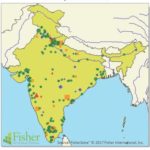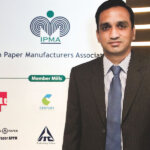Water is a precious commodity and nature’s greatest gift to the living kingdom; every industry has the onus to preserve it. The paper industry’s recent impetus on water conservation and reducing pollution load in effluents is commendable from every aspect, resulting in astounding outcomes.
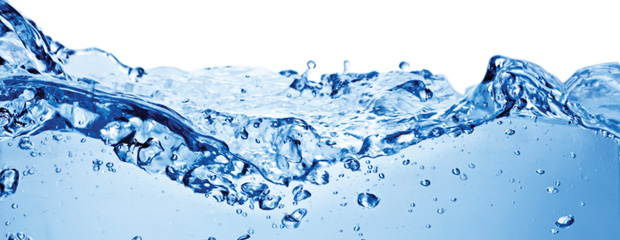
The pulp and paper industry depends critically on water and is characterized as highly water intensive. It wouldn’t be a hyperbole to say ‘no water means no paper’. The industry’s concern vis-à-vis water has been mainly on two accounts, viz. high consumption and high pollution load, both of which have been consistently worked upon to be brought in the lowest permissible range as stipulated by pollution regulation bodies.
To reduce and treat the large wastewater discharge, the industry lately has adopted resource and waste minimization concept with the aid of cleaner production programs and improved technology. The Indian pulp and paper industry by far has sufficiently succeeded in implementing water conservation practices through improved housekeeping, optimized process parameters, increased recycles, and adaptation to water-focused technology.
Paper Mart recently conducted a series of short interviews on criticality of water and ways to improve its usage. Here are the views expressed by spokespersons of various companies of the Indian pulp and paper industry:
ITC Ltd-PSPD
 Integrated pulp and paper industry in India have reduced specific water consumption (SWC) from an average value of 150 CUM/T of production in 2000-01 to 60 CUM/T in 2012-13. Currently, the value ranges between 40-60 CUM/T based on plant capacity, technology adopted and overall water efficiency of the plant. Charter for Water Recycling and Pollution Prevention in Pulp and Paper Industries (specific to Ganga River Basin States) has now mandated further reduction in SWC for integrated pulp and paper industries to 50 CUM/T, to be achieved by March 31, 2017. Corresponding discharge parameters have also been made significantly stringent. Similarly, norms for other categories of paper mills in Ganga River Basin States have also been tightened. It is expected that above mentioned norms will shortly be applicable on pan India basis. Hence, entire pulp and paper industry in India is putting its best efforts to meet the norms. This is being done not only through reduce, reuse and recycle, but also through cost intensive technology up-gradation.
Integrated pulp and paper industry in India have reduced specific water consumption (SWC) from an average value of 150 CUM/T of production in 2000-01 to 60 CUM/T in 2012-13. Currently, the value ranges between 40-60 CUM/T based on plant capacity, technology adopted and overall water efficiency of the plant. Charter for Water Recycling and Pollution Prevention in Pulp and Paper Industries (specific to Ganga River Basin States) has now mandated further reduction in SWC for integrated pulp and paper industries to 50 CUM/T, to be achieved by March 31, 2017. Corresponding discharge parameters have also been made significantly stringent. Similarly, norms for other categories of paper mills in Ganga River Basin States have also been tightened. It is expected that above mentioned norms will shortly be applicable on pan India basis. Hence, entire pulp and paper industry in India is putting its best efforts to meet the norms. This is being done not only through reduce, reuse and recycle, but also through cost intensive technology up-gradation.
While cost of fresh water treatment varies between Rs. 4-8 per CUM, depending on the source, recycle of treated effluent through reverse osmosis process costs approx. Rs. 30 per CUM with large capital investment, making such recycle commercially unviable.
J K Paper Ltd
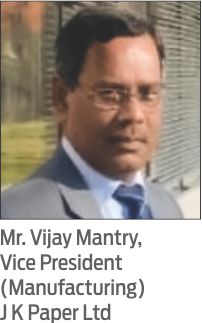 Even though the pulp and paper industry is still highly dependent on fresh water, there have been some remarkable achievements with regard to the water-use patterns. For instance, at JK Paper we could cut water use by fifty percent, while the production has doubled after our new project was commissioned. As large industrial users of water, the pulp and paper industry has long managed water in the context of a regulatory environment. However, the scenario is changing and water is now getting unprecedented focus due to following reasons.
Even though the pulp and paper industry is still highly dependent on fresh water, there have been some remarkable achievements with regard to the water-use patterns. For instance, at JK Paper we could cut water use by fifty percent, while the production has doubled after our new project was commissioned. As large industrial users of water, the pulp and paper industry has long managed water in the context of a regulatory environment. However, the scenario is changing and water is now getting unprecedented focus due to following reasons.
The brown-field expansions are not possible unless we manage the expanded capacity with same amount of water available. Another reason is that the industry is thriving to be world class, for instance at JK, PM6 manufactures paper at water consumption of less than 10 m3/tonne of paper. This is possible only because of conscious efforts that have been made while selecting the equipment in the project phase. Lastly, the water conservation is also a contributing factor to reduce the energy costs. Most of our pulping process is designed at medium consistency resulting in lower fresh water consumption as well as less pumping cost.
Water management can be divided in to two categories. 1) General and facilities water management (i.e., goals, targets, audits, good housekeeping), and 2) process strategies (i.e., upgrading equipment, optimizing water re-use, reducing losses).
Though we have improved a lot in last decade, the scope for improvement is unlimited. We are still far away from creating closed loops in our process due to recycling of water within the system has its own inherent problems. Closed water circuits create a favorable environment for the growth of micro-organisms, which lead to increased build-up of slime deposits that causes severe operational problems.
The current best practices can only result in incremental improvements. The clear cut barrier to leapfrog in this area is lack of innovative technologies at affordable cost. The available options such as membrane technology, evapo-concentration, MBR process, 3FM technology etc. are appearing to be cost prohibitive in near future.
The West Coast Paper Mills Ltd
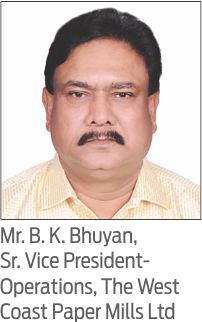 Water is one of the most important natural resource available in our planet next to oxygen. As a responsible corporate, WCPM recognizes the critical need to harmonize its business interests with that of the need for resource conservation and cleaner environment. Guided by the principle of environment responsibility, the company manufactures paper and boards with an earnest water conservation and consumption reduction policy in place. Today, as per Environmental Audit statement for the year ending 31st March, 2016, our process water consumption per unit of products is 87 cubic meter, which has been further reduced significantly for the year ending March 2017.
Water is one of the most important natural resource available in our planet next to oxygen. As a responsible corporate, WCPM recognizes the critical need to harmonize its business interests with that of the need for resource conservation and cleaner environment. Guided by the principle of environment responsibility, the company manufactures paper and boards with an earnest water conservation and consumption reduction policy in place. Today, as per Environmental Audit statement for the year ending 31st March, 2016, our process water consumption per unit of products is 87 cubic meter, which has been further reduced significantly for the year ending March 2017.
Our twin pronged approach to reduce toxic chemicals in pulping and other processes and to treat finally the effluent has resulted in significant recycling of the treated wastewater, thereby consuming less fresh water. Oxygen delignification and ECF adopted at pulping stage are the examples of such cleaner technologies. Moreover, these technologies have resulted in reducing the pollution load in effluent to a considerable extent making possible to attain parameters such as BOD, COD, TSS, TDS, color, etc. well within permissible limit.
The Company is committed towards green production, resource conservation, and responsible waste management. This commitment from WCPM has reflected in its ‘minimum impact-best process’ technology: green production, resource conservation, responsible waste management and a reduced pollution load. Evident record in each of these areas makes the company an environmentally-compliant paper mill.
Emami Paper Mills Ltd
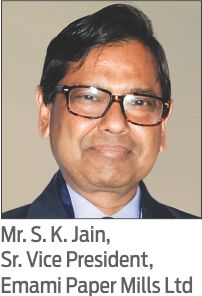 Paper and Pulp manufacturing either by wood, agricultural residues or recycled based raw material is highly capital, energy and water intensive industry. In today’s scenario, where drinking water sources are reducing and water availability for human consumption is a great issue globally, it is a responsibility of all concerned to take utmost care to reduce fresh water consumption. To save water, natural water resources like ground water, river water is required to be preserved without mixing of pollutants.
Paper and Pulp manufacturing either by wood, agricultural residues or recycled based raw material is highly capital, energy and water intensive industry. In today’s scenario, where drinking water sources are reducing and water availability for human consumption is a great issue globally, it is a responsibility of all concerned to take utmost care to reduce fresh water consumption. To save water, natural water resources like ground water, river water is required to be preserved without mixing of pollutants.
Most of the industries are located in the vicinity of a river or near ground water sources. To keep rivers clean and to avoid depleting of ground water level, it is essential to reduce water consumption in the industry by adopting various advance technological measures and recycling the same back in the process. In paper industry, the standard norms prescribed by regulatory authorities are close to the international norms but still there is a lot of scope to reduce it further. By 2020, paper production is expected to be doubled resulting further increase in water consumption. There is already growing conflicts due to water scarcity and pollution. Integrated approach towards zero discharge may be adopted by segregation of wastewater from various processes and reuse the same by adopting advance technological solutions depending upon waste water quality at source. The concept of zero discharge is based on ‘reduce, recycle and reuse’ principle without affecting productivity and quality of the product. These all should be taken care as an inbuilt part of the technology for selecting manufacturing process. Closing of water system often leads to increase dissolved solid, suspended solid, temperature and reduction of oxygen. The suitable techniques should be adopted to address above challenges without affecting productivity.
At Emami Paper Mill, to reduce water consumption various techniques have been adopted like reuse of water at source, reusing hydraulic cooling water by installing cooling towers, vacuum pump water recycling, installation of technologically advanced disc filter, usage of technologically advance filters, maintaining the quality parameters of treated water by technologically advance effluent treatment plant (ETP) and reusing the same by installing multi-media filter, installation of RO Plant, reutilizing of blow down water from cooling tower and boiler etc.
The capital investment for achieving the result should be done smartly depending on the wastewater availability at source and reutilizing applications. To maintain ground water level, construction of rain water/storm water recharge well is an important activity to preserve the water table. Emami has done tremendous job in this direction. The reduction of water consumption and wastewater management is a continuous process for existing and future facilities to accept the challenge of acute water shortage and reduction of pollutant load in discharge treated effluent.
Century Pulp & Paper
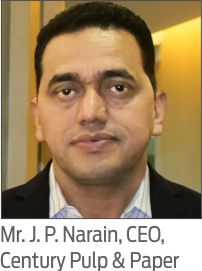 Water is a transparent and nearly colorless chemical substance that is the main constituent of earth’s stream, lakes, oceans and the fluids of most living organism. Water is used in all industries like power generation, food processing, textiles, steel, pharma and pulp and paper etc. In pulp and paper industry, water requirement is very high as it is being used for transportation of pulp within the manufacturing process. Water consumption of 37 cubic meter/tonne of product has already been achieved by Century Pulp and Paper which was 79 cubic meter/ tonne in the year 2011-12 by adopting 3R cycle, i.e. reduce, reuse and recycle for water management.
Water is a transparent and nearly colorless chemical substance that is the main constituent of earth’s stream, lakes, oceans and the fluids of most living organism. Water is used in all industries like power generation, food processing, textiles, steel, pharma and pulp and paper etc. In pulp and paper industry, water requirement is very high as it is being used for transportation of pulp within the manufacturing process. Water consumption of 37 cubic meter/tonne of product has already been achieved by Century Pulp and Paper which was 79 cubic meter/ tonne in the year 2011-12 by adopting 3R cycle, i.e. reduce, reuse and recycle for water management.
The main steps taken for water conservation are the implementation of 34 water conservation schemes, complete recirculation of paper machines white water in pulp mill through clarification and filtration, installation of polydisc filters at paper machines for water recycle reducing water consumption for 34 meter cube to 14 meter cube/tonne of paper, etc. We have also achieved complete recycling of wastewater of recycled paper plant thus zero liquid discharge and have installed a tertiary treatment plant having equalization tanks with diffusers, MBBR, tertiary clarification, chemical treatment and tube settlers for reuse of treated wastewater in place of fresh water for log/chips washing, gardening and floor cleaning etc. Century has also installed a state-of-the-art technology in the fiber line with environment friendly elementary chlorine free (ECF) technology with twin roll presses which has resulted in reduction of water consumption significantly.
Implementation of innovative technologies for treatment of wastewater to further reduce the water consumption is the need of the hour which should be done continuously to ensure environment protection for the sustainable operation of paper sector.
Pudumjee Industries Ltd
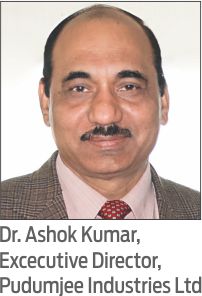 Pulp and paper industry is highly dependent on the use of water due to nature of pulp and paper making process. Since water is a critical resource, the responsible management of pulp and papermaking process is very important to optimize and reduce the fresh water consumption.
Pulp and paper industry is highly dependent on the use of water due to nature of pulp and paper making process. Since water is a critical resource, the responsible management of pulp and papermaking process is very important to optimize and reduce the fresh water consumption.
Indian pulp and paper industry has come a long way to reduce its fresh water consumption over a period of time and more so after implementation of CREP launched in 2003 with a view to go beyond the compliance of regulatory norms for prevention and control of pollution through various measures including waste minimization, in-plant process control and adoption of process technologies. More recently, CPCB in 2012-13 implemented a Charter for water recycling and pollution prevention in pulp and paper industry in Ganga river basin fixing stringent norms for fresh water consumption, effluent generation and treated effluent quality. This has now been extended with some modification sector-wise for entire pulp and paper industry in India.
Indian paper industry has fully co-operated with the regulatory authorities to achieve the desired targets which are quite stringent to achieve even with a high capital investment and downtime required to upgrade the technology. However, there is a need to understand and appreciate the status of our own industry and not compare it all the time with global pulp and paper industry and thus stay away from negotiation type approach. Though it is easy for academicians and researchers and other stake holders to suggest “Zero Discharge Mill” and “Almost 100 percent closure and recycling of treated effluent” but this is not the reality anywhere in the world. Many a times the proposed solutions look promising in the laboratory or on pilot scale but their scale-up for real life situation has to be implementable in a cost effective manner which is not always possible. The experts must give insight into the techno-economically viable solutions which are practical and not adopting the rhetoric approach all the time which is observed at various forums. It goes without saying that the industry must strive for continuous improvement to reduce fresh water consumption and improve its overall environmental performance.
A plethora of literature is available about the options available to paper industry to reduce fresh water consumption and improve its environmental management. The approach and actions taken will be specific to any given mill due the diversified nature of the industry mentioned above, local and site specific issues.
While paper industry must ensure proper implementation and self monitoring of its environmental performance as per agreed norms, the regulatory authorities should also do the honest monitoring with adequate checks and balances and recognize/reward the well performing mills without any harassment. The non complying mills should be given reasonable time/opportunity to comply and improve failing which necessary actions may be taken.
Orient Paper & Industries Ltd.
 Water is the elixir of life. However for the paper industry, it is a conveying medium also which results in large consumption of water. About 85 percent of water consumed in the pulp and paper industry is used for processing resulting in generation of large volume of wastewater. In the recent past, various mills have reported the consumption of water to the tune of 100 to 220 cubic meter for writing & printing, 90-160 cubic meter for newsprint, and 60 to 150 cubic meter per tonne for packaging grade. The water consumption varies from mill to mill depending on the level of technology, process employed and use of mix raw material as well as low cost of water.
Water is the elixir of life. However for the paper industry, it is a conveying medium also which results in large consumption of water. About 85 percent of water consumed in the pulp and paper industry is used for processing resulting in generation of large volume of wastewater. In the recent past, various mills have reported the consumption of water to the tune of 100 to 220 cubic meter for writing & printing, 90-160 cubic meter for newsprint, and 60 to 150 cubic meter per tonne for packaging grade. The water consumption varies from mill to mill depending on the level of technology, process employed and use of mix raw material as well as low cost of water.
Consequent to the publishing of charter in 2015 by Central Pollution Control Board (CPCB), the mills are required to meet the target of consuming 50 cubic meter and discharging effluent not more than 40 cubic meter per tonne of product. And the mill discharging into various streams/water bodies which meets Ganga river basin (GRB) must maintain zero discharge condition. The paper industry as such responded in a very positive way and upgraded the effluent treatment plant by adopting latest technology as well as by initiating various implant measures through the process of reduce, reuse and recycle (3R). It is understood that many mills have completed upgradation measures and started complying the charter norms. As per the charter the deadline is 31st March, 2017.
Most of the mills have installed online continuous measurement as a requirement stipulated by CPCB as well as state pollution control boards. The boards in turn do the constant monitoring by getting round the clock data regarding flow and other characteristic of the effluent at their respective monitoring centre. While meeting the requirement of quantity discharge, the mill has to grapple with the high level of dissolve solids.
The most of the industry have invested heavily in upgradation of technology and conservation measures have started bearing fruits and are likely to meet the global norms in near future. Wish the industry good luck for commendable efforts!
Seshasayee Paper & Boards Ltd
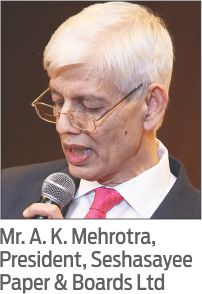 Water is integral for manufacture of pulp and paper. Most of integrated paper mills and recycled fiber based paper mills have considerably brought down specific water consumption in the last 15 years. At Seshasayee Paper & Boards, we have been able to bring down specific water consumption to 55 cubic meter from 85 cubic meter per tonne by constantly focusing on “ Reduce, Reuse and recycle” mantra in recent past.
Water is integral for manufacture of pulp and paper. Most of integrated paper mills and recycled fiber based paper mills have considerably brought down specific water consumption in the last 15 years. At Seshasayee Paper & Boards, we have been able to bring down specific water consumption to 55 cubic meter from 85 cubic meter per tonne by constantly focusing on “ Reduce, Reuse and recycle” mantra in recent past.
We are working further to achieve specific water consumption target of 50 cubic meter per tonne by CPCB in the next couple of months. Innovative ideas like recycling of vacuum pump and roll tray water for fiber and water recovery are yielding positive results in containing specific water consumption. While Zero Liquid Discharge (ZLD) is being practiced in some recycled fiber based mills, it is a challenge for large integrated paper mills. Efforts are being made to recycle difficult effluent of pulp mill after chemical, UF/ RO, carbon and sand filter treatment to remove color and total suspended solids. The viability of such treatment will have to be improved. Given the huge push to water conservation by CPCB and the industry, I am confident we will meet the challenges ahead.
Maxim Specialty Chemicals Pvt. Ltd.
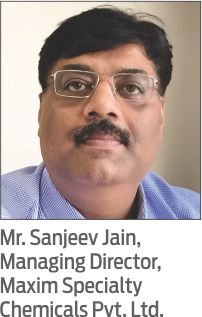 As we know water is a key resource for any paper mill and it is impossible to produce paper without water. And that statement underlines the significance of water in survival of any paper mill. Therefore, it is imperative to save this vital resource as much as we can by implementing an effective approach named “3 R” which is Reducing, Reusing and Recycling. In fact that is what is driving and pushing all the stakeholders such as paper mill management, machine, ETP and chemical suppliers to innovate and come up with newer technologies to help mills achieve Zero Liquid Discharge (ZLD).
As we know water is a key resource for any paper mill and it is impossible to produce paper without water. And that statement underlines the significance of water in survival of any paper mill. Therefore, it is imperative to save this vital resource as much as we can by implementing an effective approach named “3 R” which is Reducing, Reusing and Recycling. In fact that is what is driving and pushing all the stakeholders such as paper mill management, machine, ETP and chemical suppliers to innovate and come up with newer technologies to help mills achieve Zero Liquid Discharge (ZLD).
We are now seeing some new development happening around ETP regions such as installation of Sedicells before primary clarifier to help separate fibers & fines and reuse them back in the process and reduce BOD, new aeration techniques for maximum COD reduction, anaerobic reactors for the sludge in order to achieve ZLD and use it’s by products in the process, especial media filters and ozone treatments for tertiary treatments, new chemicals for color removals to name a few. Now, with CPCB also insisting on paper mills to go for ZLD, we can well expect more developments in those areas to save water because if there is NO water then there will be NO paper and also NO life!
Amar Elastomers Pvt. Ltd & MR Mac-Tech Pvt. Ltd.
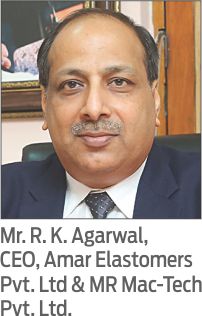 As all direct and indirect costs in running the paper machine are on a upward move on day to day basis, we are facing challenges in improving machine performance and reducing energy costs. To keep the paper industry healthy, industry and key suppliers must jointly come up with a feasible solution by getting the current machine operations audited. And, this definitely needs a team of competent technicians and auditors.
As all direct and indirect costs in running the paper machine are on a upward move on day to day basis, we are facing challenges in improving machine performance and reducing energy costs. To keep the paper industry healthy, industry and key suppliers must jointly come up with a feasible solution by getting the current machine operations audited. And, this definitely needs a team of competent technicians and auditors.
Firstly, coming to Fourdrinier section, the function of this section is to dewater the stock, build web and transfer this to the press section at best or maximum consistency and efficiency. This maximum self drainage and turbulence along with forced drainage in the Fourdrinier would of course result in better sheet formation with maximum drainage in this section, resulting to better water removal efficiency and thus saving energy. It should be noted that selection of designed dewatering units along with the calculated placement of these units is very important.
Secondly, the press section dewaters the sheet, and improves sheet tests, and transfer the sheet to dryer section at best maximum consistency. To be more precise, the pressing of paper web is a mechanical operation which uses rolls of various designs and wet felts of various constructions to remove water from the web, so as to achieve the desired consistencies and properties of sheet. In other words, the optimum operation of the press section is selection of roll design, selection of fabric design and the selection of fabric cleaning system. These would lead to the goals of press section optimization: reduced breaks, decreased moisture, increased felt life, less felt change down time, enhanced speed, and improved quality.
As a roll manufacturer, I had been continuously on the track of improving the designs of roll covers like Optimal Drill Designs for enhanced water drainage along with delivering more hard ceramic rolls in the industry and improving the oxide cover materials to serve the industry with more cover life and sheet properties.


